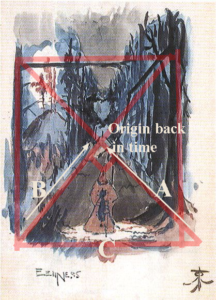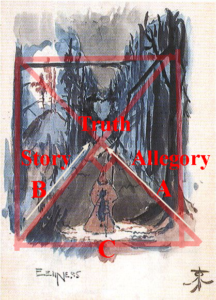Tolkien’s Dialectic Elsewhere.
Sir Gawain and the Green Knight.
 We can clearly see the planar dialectic incorporated into Tolkien’s analysis of Sir Gawain and the Green Knight in which the “passing world of values” and “code of honour” are designated as A and B which intersect at the centre C in Eeriness:
We can clearly see the planar dialectic incorporated into Tolkien’s analysis of Sir Gawain and the Green Knight in which the “passing world of values” and “code of honour” are designated as A and B which intersect at the centre C in Eeriness:
“We have in fact reached the point of intersection of two different planes: of a real and permanent, and an unreal and passing world of values: morals on the one hand, and on the other a code of honour, or a game with rules. The personal code of most people was, and of many still is, like that of Sir Gawain made up of a close blend of the two; and breaches at any point in that personal code have a very similar emotional flavour. Only a crisis, or serious thought without a crisis (which is rare) will serve to disentangle the elements; and the process may be painful, as Gawain discovered” (TMatC 89).
Ancrenne Wisse.
His planar dialectic can be found in his analysis of Ancrene Wisse in which he describes two manuscripts as  inheritances of the same “time and place” and sharing the same origin pointing to the same centre. As Tom Shippey notes in TRtMe in the opening chapter “‘LIT. AND LANG. Old Antipathies“, Tolkien opens his essay with a shot across the bows at ‘Literature’ (A in Tolkien’s scheme if you remember), describing it as “innunendo” and the “repeated Tolkienian joke” (TRtMe 7). Tolkien refers to time and place (time and space) no less than fifteen times throughout the essay.
inheritances of the same “time and place” and sharing the same origin pointing to the same centre. As Tom Shippey notes in TRtMe in the opening chapter “‘LIT. AND LANG. Old Antipathies“, Tolkien opens his essay with a shot across the bows at ‘Literature’ (A in Tolkien’s scheme if you remember), describing it as “innunendo” and the “repeated Tolkienian joke” (TRtMe 7). Tolkien refers to time and place (time and space) no less than fifteen times throughout the essay.
He refers to the manuscripts as A and B sharing a point “AB”. He refers to the two together as “AB language”.
“And if we examine the other versions of B, I submit that it is language (AB) that lies behind each of them, not some other type from which B or its immediate antecedents were ‘translated’.
I also submit, though the case is far more intricate and totally different conclusions have been reached, that the same is true of A ; that the least forced explanation of the linguistic state of the other versions of the Ancrene Wisse is that behind them, at different removes, lies an original in language (AB).
Yet even if this is not to be demonstrated or agreed, the purity of the language (AB) in A and B, remains far less probable or credible than the belief that the originals of A and B were in the same language and spelling (AB), and therefore belonged to much the same time and place. It is a belief which is at least supported by the connexion that is thus established between the nature of the language and spelling of these texts on the one hand, and their literary and stylistic quality on the other. Both point to a place where native tradition was not wholly confused or broken; both point to a centre where the native language was not unfamiliar with the pen; it is not surprising if they both point to the same place” (Ancrene Wisse and Hali Meiðhad 119).
For a more thorough discussion see Appendix IV.
Allegory and Story.
It reappears in his comments on “Allegory” and “Story”, A and B which “start out from opposite ends” and converge  on “Truth” at C:
on “Truth” at C:
“Of course, Allegory and Story converge, meeting somewhere in Truth. So that the only perfectly consistent allegory is a real life; and the only fully intelligible story is an allegory. And one finds, even in imperfect human ‘literature’, that the better and more consistent an allegory is the more easily can it be read ‘just as a story’; and the better and more closely woven a story is the more easily can those so minded find allegory in it. But the two start out from opposite ends” (Letters 174, #109).
In both instances we see a reference to the “X” of the two trees entangled in “disentangle” and “closely woven”. The word “crisis” gives: “decisive point in the progress of a disease,” […] point at which change must come, for better or worse,” from […] Greek krisis “turning point in a disease, that change which indicates recovery or death“. The “point” is the top, the “naith”, the “queer corner”, the triangle at the Door, the “turning point”. Tréowine accompanied Ælfwine on his voyage. The last thing Tréowine saw was the Straight Road: “the old road goes, as an unseen bridge”. His name “true friend” (SD 293) references both “Truth” and the triangle “Friend” of Foxrook.
[6] This illustrates one of Tolkien’s riddling methods. No explicit link between “necessity” and the hands and wheels metaphor is given, but the hint lies in the proximity of the two on the page, much like the blue mountains next to the hat of Gandalf in the riddle of the Rivendell hidden imagery. We observed the same allusory technique in The Place of the Lion.
[7] Tolkien said that Minas Tirith “is at about the latitude of Florence” (Letters 528, #294). In Domenico di Michelino’s painting Dante Before the City of Florence, Dante appears holding his Divine Comedy outside the walls of Florence, with the Mount of Purgatory, depicting his exile. In LotR Elrond withholds the heirlooms and the hand of his daughter Arwen from Aragorn much like Tolkien was exiled to his own purgatory when Friar Francis forbid contact with Edith until he was twenty one. Tolkien used this motif in the Beren and Lúthien story. We know that Beren and Lúthien are Tolkien and Edith. Beren mistakes Arwen for Lúthien in Cerin Amroth (LotR Appendix A.V.1058). Paradise is at the top of Mount Purgatory implying Tolkien’s escape from his own purgatory and apprehension of paradise with Edith-Arwen.
[8] Tolkien refers to “Lit” (A) as “she” in his poem “Lit’ and Lang'” (J.R.R. Tolkien, E.V. Gordon & others 25). The reconciliation of this with my hypothesis which in its current simplified form states that the oak (A) is Tolkien and the birch (B) is Edith, requires a discussion of the “third substance” in the World Soul which is a mixture of A and B, “male” and “female” (though not strictly genders). This substance is the World “that is”. In the geometry of Eeriness there are two butterflies, A and B, but each butterfly has two wings (two triangles), each also A and B. In Before we can see that the wings of the hidden figure equate to the two left and right triangles and the two spirals. Each character has an oak and a birch side. As a couple Tolkien and Edith are two halves of one whole consisting of ABBA. Each wing is a half of the Door. Thus in order for the Door to function, to proceed through the Door (to the heart), both male and female must be present in the Music, in harmony. Unity is created from shared harmony, by incorporation of the other half, as opposed to the “unity of its own” of Melkor’s discords. These interrelations reverse during the course of a narrative because Tolkien’s world is based on the duality of mirror reflections. Only Eru is “One”.
[9] Branchaw, Sherrylyn. “Elladan and Elrohir: The Dioscuri in The Lord of the Rings.” Available at: https://doi.org/10.1353/tks.0.0081.
[10] Larsen, Kristine (2022) “Seeing Double: Tolkien and the Indo-European Divine Twins” Available at: https://dc.swosu.edu/mythlore/vol40/iss2/10.
[11] Libran Moreno, Miryam. “Parallel Lives: The Sons of Denethor and the Sons of Telamon.” Available at: https://doi.org/10.1353/tks.2005.0024.
[12] Higgins, A. “Tolkien on Holiday”. Available at: https://journals.tolkiensociety.org/mallorn/article/view/181.